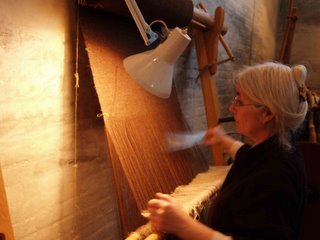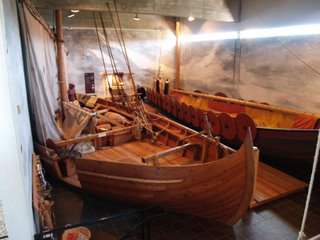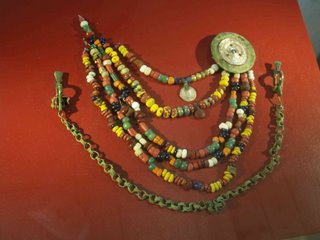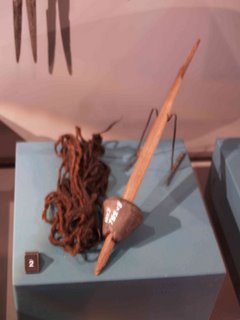As I mentioned on the last posting, the Viking Ship Museum has no artifacts, other than the ships themselves.
The main artifact collections are housed at the Roskilde Museum. The institution is more of a complex spread around the core of town (kind of like the Smithsonian on a smaller scale). I spent most of Wednesday in the 'historic' collection. This is housed in a set of interlocking buildings dating roughly to the mid 1700's.
I obviously spent hours with the Viking Age and Medieval materials. Here in Denmark, they seem to divide things into 'Early History' and then 'Medieval', with the break at 1000 AD. This messes me up anyway, since it cuts across what I would be looking at for the Viking Age. Our perspectives in North America are shaped with the English experiences: 450 for the end of the Romans, 500-800 for the Saxon invasions, 800 -1066 for the Viking Age, 1066 and on for the Normans.
It turns out the early Viking Age history of Roskilde is a bit vague, and not well represented in the artifact record. The earliest references to Roskilde run from roughly 1030 - 1050. The earlier settlement remains have never been found. For this reason, there were few objects in the museum from the core part of the Viking Age. From this late Viking Age period, through the Middle Ages, Roskilde served as and important centre for trade, political and religious power. The Catholic Church established a number of buildings here, centered mainly on the tall hill that dominates the area.
(Note, I expand on the description of Roskilde town on todays 'Hammered Out Bits' posting)All this taken into account, the Viking Age materials represented a the Roskilde Museum amount to maybe 200 artifacts. I took photographs of almost everything, with notes mainly on dates and my own observations. The descriptive texts were quite limited (and of course in Danish, which I can't read anyway).There were no reconstructions or even images of the objects in use. This is a short coming of the museum, as without context, objects mean less to the average viewer. Objects were most often grouped by type, not necessarily detailed in date or find location. The lables did not contain the object registration numbers. This would make attempting to identify individual pieces for latter reference a challenge.
I had contacted museum currator Jens Ulriksen ahead about my visit, and he kindly too some time to introduce me to the VA collections.
Most interesting of all (for me) was a grave grouping from about 800 AD. A female buried with a spear, the body laid over with three massive stones. (Does this sound familure?) Combined with a male, legs crossed (bound) arms thought to have been bound to the sides - with the neck broken. I recognized this right off from the work of Neil Price, who some of us met at Haffenreffer a couple of years back. Very cool!
There was also a very nice pattern welded sword, in extremely good condition. Two cores, I think I counted 9 or 10 layers to the rods. Although not dated (other than Viking Age) I would guess early. It was only 65 cm of blade and quite wide, about 8 cm.
Upstairs in the Medieval section were also a number of pieces that were 'late Viking Age' - from roughly 1050 to 1100.
The huge score here was a fragment of woolen textile. I did my best to get a clear close up shop (through the glass and in the dark). Again no details, save a date at 1100. Looked like wool, my estimate was about 10 -12 threads per cm. There were seveal groupings of spindle whirls, plus one complete spindle (original wood shaft) which also had its wool yarn (no date).
There was also a large collection of leather shoes, easily 15 or 20, mainly from 1300 -1400. There was a single (flat) sample dated to 1100. The types were mostly turn shoes, several with centre seams (like the Yorvik style).
A reasonable amount of small iron objects. Several groupings of glass beads. Four complete sewing shears (Meghan will be keen on those images - the objects here show I was correct about the thickness of the spring sections.)
I did chat a fair amount with the only staff member working in the building. This was curious in itself (we did talk funding and cut backs, the universal problem). The age of the building means that it was a series of smaller rooms linked together, most of them about modern living room size. The materials were grouped by theme. It was presented more as a Victorian styled 'stuff' museum. With only one person to mind admissions, there was no provision for interactive presentations.
This balanced by the low activity. Remember that this was a weekday morning, and really off season at that. Even still, over the five hours I was there, I saw five other people plus one school group. The kids were maybe grade 4, and spent about 20 minutes with the VA exhibit and were gone. (This involved in some kind of 'pick and object and then draw it' project. And yes, I was too asked to interpret the collection for the kids, but of course could not lecture in Danish - Neil)
I must admit that we have been spoiled by the last couple of large international exhibits we have worked on!
Labels: travelogues
 This is the woman I mentioned who is working on the sail weaving project. She is here packing a line of weft with her sword beatter. Got some interesting advice on the correct way to make one of these. She also had a number of samples of cloth using various threads that they had made up as test samples. (The thread weights are in my head...)
This is the woman I mentioned who is working on the sail weaving project. She is here packing a line of weft with her sword beatter. Got some interesting advice on the correct way to make one of these. She also had a number of samples of cloth using various threads that they had made up as test samples. (The thread weights are in my head...) This is an overview of the activity room. The Knorr hull is to the left, the longship to the right, with the weaving station to the rear. The hull replicas are full scale.
This is an overview of the activity room. The Knorr hull is to the left, the longship to the right, with the weaving station to the rear. The hull replicas are full scale. This is the woman's grave described in the last post. Clearly 'killed' as we had learned about from Neil Price. Very interesting. (See what happens to women that get too uppity...)
This is the woman's grave described in the last post. Clearly 'killed' as we had learned about from Neil Price. Very interesting. (See what happens to women that get too uppity...) A series of glass bead strands. The text stated 'from a number of graves', but that description applied to the entire case, and there were also a number of smaller clusters of beads. (And yes Neil [Peterson, of DARC- ed.], the other groupings were closer to 15 beads each.) Not sure if this grouping had been seen in other catalogues.
A series of glass bead strands. The text stated 'from a number of graves', but that description applied to the entire case, and there were also a number of smaller clusters of beads. (And yes Neil [Peterson, of DARC- ed.], the other groupings were closer to 15 beads each.) Not sure if this grouping had been seen in other catalogues. This is the drop spindle with wool yarn. Sorry that the image is not the sharpest. The image was taken hand held at about 1-15 second exposure.
This is the drop spindle with wool yarn. Sorry that the image is not the sharpest. The image was taken hand held at about 1-15 second exposure.








